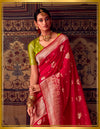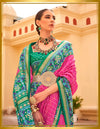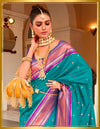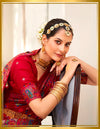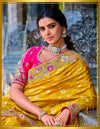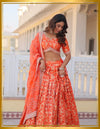Saree Types in India with Names and Images | 116 Official Sarees

In India, a saree is not just a garment, it is a feeling. Folded in the corner of a trunk, draped across temple steps, caught in the wind on a train platform. Sarees are the fabric of memory. Each region weaves differently. Each community wears differently. And each thread carries more than colour — it carries identity.
This guide covers all handloom sarees in full detail — not as a checklist, but as stories woven through India’s soil. At the end, you will also find the complete list of 116 official sarees recognised by the Indian Handloom Board.
1. Paithani Saree – Maharashtra

Paithani sarees come from a town called Yeola in Maharashtra. For over 2000 years, the weavers here have worked on handlooms using pure silk and zari made of silver threads dipped in gold.
What makes Paithani stand out is its border and pallu. Motifs like the peacock, lotus, parrot, and asawalli creepers are not printed or embroidered — they are handwoven using tapestry technique. This means every colour in the motif is from a different thread, inserted line by line. The base is usually plain or striped — in colours like aubergine (called ‘aubergine Paithani’), turmeric yellow, or leaf green.
Traditionally worn by Marathi brides during weddings, these sarees were once traded for their weight in gold. They are so durable that you will find them wrapped in old cotton sheets in your grandmother’s trunk, still shining after 40 years. Today, Paithani is both an heirloom and a fashion statement — worn on stage by classical dancers, gifted to pregnant daughters-in-law during 'dohale jevan', and revived in ramp collections by designers like Gaurang Shah.
Making one real Paithani takes between 1 to 6 months, depending on the complexity of the border. The weaving community in Yeola still survives mostly on this art — although cheaper powerloom copies now crowd the market.
2. Kanjivaram Saree – Tamil Nadu

A Kanjivaram saree is not stitched or glued — it is engineered. From the temple town of Kanchipuram, these sarees are made using the highest quality mulberry silk and real zari. The body and pallu are often woven separately and then interlocked with a korvai technique, so strong that even decades later the joint does not fray.
Motifs are drawn from South Indian temple architecture — yaalis, chakras, peacocks, mangoes, and gopuram borders. You will find deep colours like bottle green, vermilion red, royal blue — all with wide borders that sometimes gleam like polished brass. The zari is real silver coated in gold, woven not printed, and weighed in grams — sarees can carry over 100 grams of zari alone.
In Tamil Brahmin weddings, a Kanjivaram is as crucial as the mangalsutra. The bride changes multiple times, but her main wedding saree is always Kanjeevaram — usually red and gold. Classical dancers wear it. Politicians wear it. Grandmothers pass it on. Owning one is a rite of passage.
Handloom weavers in Kanchipuram still operate pit looms in homes, many of them working barefoot in semi-darkness with only the rhythm of the shuttle and a tube light overhead. Despite knock-offs, original Kanjeevarams still hold the crown, both for grandeur and weight.
3. Pochampally Ikat Saree – Telangana

Pochampally is a small town an hour away from Hyderabad, but it has global status thanks to one word: Ikat. Here, weavers use a technique called tie and dye resist on both warp and weft threads before weaving them together to form kaleidoscopic patterns. That means the design is mapped and dyed before the saree is even woven.
Geometric shapes — diamonds, squares, arrows — dominate the visual language. The colours are bold and modern: black with red, white with orange, or green and gold. Unlike printed patterns, these motifs are slightly fuzzy — a signature of real Ikat.
Pochampally sarees are often worn during festivals like Ugadi and Sankranti. Government school teachers, lecturers, and civil servants wear them with pride — a subtle nod to their middle-class roots and cultural pride.
The saree’s production has now gone beyond just handloom to include powerloom varieties and even global fashion adaptations, but the soul of Pochampally Ikat lies in its mathematical precision and the patience of weavers who work for weeks just to align patterns millimetre by millimetre.
4. Banarasi Saree – Uttar Pradesh

No Indian bridal trousseau is complete without at least one Banarasi saree — preferably red, heavy, and filled with gold motifs. Woven in Varanasi, these sarees have their origins in Mughal workshops where Persian motifs were mixed with Indian craftsmanship.
There are multiple types: Jangla (with intricate creepers), Shikargah (animal hunting scenes), Tanchoi (brocade work with no zari), and Cutwork (floral patterns using silk and cotton). The key to all of them is the zari — real gold or silver, hammered into fine threads and woven along with silk.
Making one Banarasi can take anywhere between 15 days to 6 months. The weavers — often karigars from generations of families — sit hunched over looms in the gallis of Varanasi, working in silence except for the rhythmic clack of wooden shuttles.
Today, Banarasi sarees are worn not only by brides but by performers, diplomats, and corporate women who want a piece of legacy wrapped around them during big moments.
5. Bomkai Saree – Odisha

Also known as Sonepuri, the Bomkai saree is one of Odisha’s greatest weaving treasures. It comes from villages like Bomkai and Sonepur, often woven in coarse cotton or tussar silk. The standout feature is the use of extra weft technique to insert symbolic motifs — tortoise, temple spires, wheels — directly into the body of the saree.
Traditional Bomkais come in red, black, or mustard with simple but sharp borders. Unlike other silk sarees, Bomkais are not shiny — they are matt-textured, rustic, and extremely breathable. Tribal and rural women wear them for pujas and local festivals. In recent years, they're also being adapted into designer versions with finer silk and richer colours.
These sarees carry the memory of forest settlements and old temple towns. Wearing one is like draping a hand-drawn sketch made in thread — imperfect, soulful, and rare.
6. Baluchari Saree – West Bengal

Imagine wearing the Ramayana or Mahabharata — not printed, but woven in the pallu. That is a Baluchari saree. Originating from the town of Bishnupur, this Bengal saree uses richly dyed silk and jacquard weaving to create detailed scenes: Krishna playing the flute, Draupadi’s vastraharan, or women swinging under trees.
Originally, these sarees were patronized by zamindars and were seen as markers of education and culture. Today, Balucharis are worn during Durga Puja, music sabhas, or even Bengali weddings.
They are not lightweight. They drape heavy and require good posture. But when worn, they are showstoppers.
7. Chanderi Saree – Madhya Pradesh

Woven in the town of Chanderi, near the Betwa River, these sarees are the fabric equivalent of sunlight. Chanderi is known for its sheerness — the gossamer-fine silk-cotton fabric that lets light pass through but holds its shape beautifully. You can spot one by the translucent body, narrow golden zari border, and small motifs like coins, peacocks, or lotus.
Historically patronized by the Scindia royals, Chanderi sarees are worn during religious ceremonies. The fabric is so fine that even wide pleats look graceful instead of bulky.
Local weavers say that the town's water has something in it — “Chanderi ka paani hai,” they say — that makes the fabric fall better. Whether myth or chemistry, one thing is clear: wearing Chanderi feels like carrying air wrapped in tradition.
8. Venkatagiri Saree – Andhra Pradesh
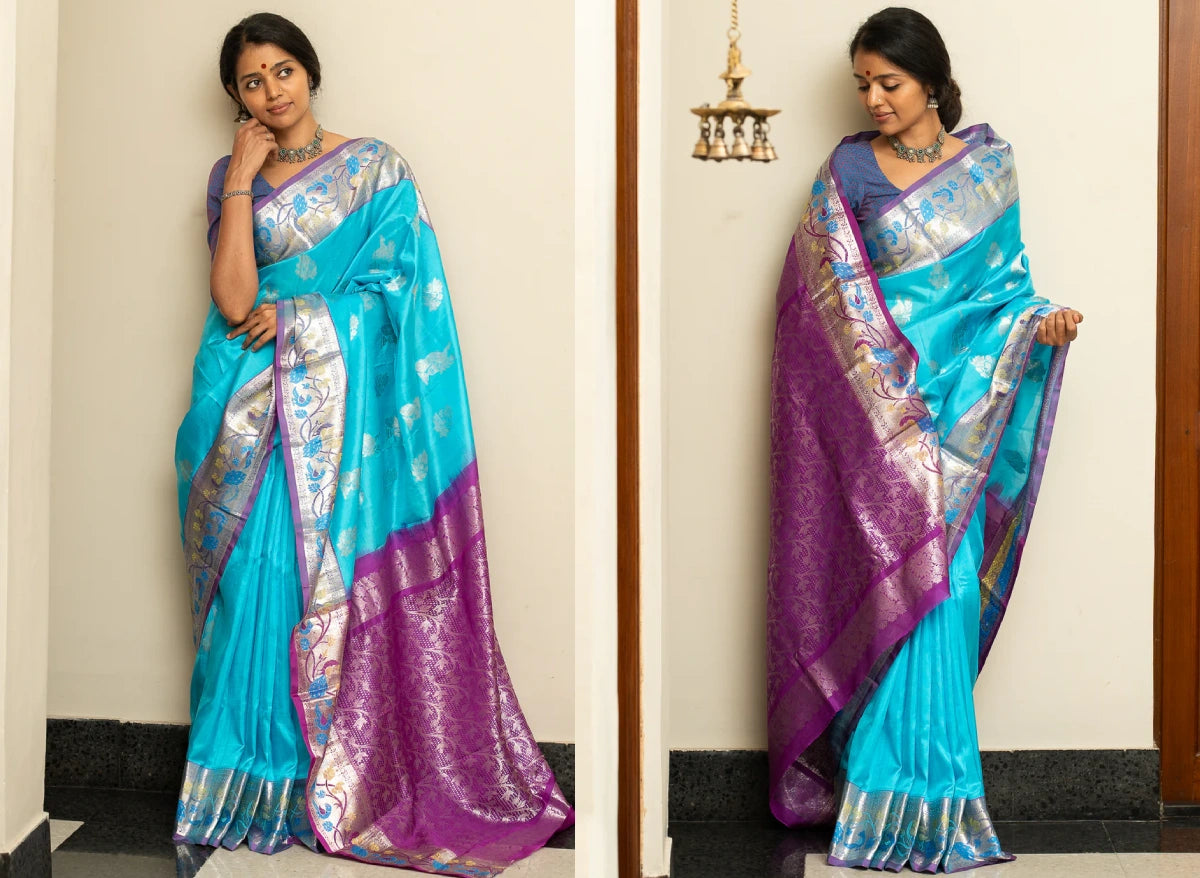
Venkatagiri sarees come from a sleepy town near Nellore, Andhra Pradesh, and they are as soft-spoken as the place itself. These sarees are made using ultra-fine cotton or silk, often with delicate jamdani motifs that appear to float on the surface. The body is usually plain or lightly striped, while the border is woven with silver or gold zari.
These are the sarees that Telugu grandmothers love — easy to wear, gentle on the skin, and elegant without effort. Ideal for Navratri, temple visits, or even just a casual Sunday puja at home.
What sets Venkatagiri apart is the softness. You can roll it up into a fist and still not wrinkle it. A proper handloom Venkatagiri will last decades.
9. Ilkal Saree – Karnataka

Woven in Ilkal town of northern Karnataka, Ilkal sarees have cotton bodies and art silk pallus dyed in bright red or maroon. The signature pallu design is called ‘tope teni’ — horizontal stripes with temple or ladder-like motifs.
Weavers in Ilkal use a method called kondi, which means the pallu is woven separately and joined to the body with a precise interlock — a cousin of the korvai technique in Kanchipuram. The borders are broad and often green, mustard, or hot pink.
These sarees are commonly worn by farmers’ wives, teachers, and working women in Karnataka. They are durable, expressive, and unapologetically loud — much like the folk songs that accompany their draping.
10. Kasavu (Balaramapuram) – Kerala

White and gold. That is all it takes to make a Malayali woman look divine. The Kasavu saree, traditionally woven in Balaramapuram, is made of fine cotton with a gleaming golden zari border. No motifs, no bright colours — just understatement at its most powerful.
It is worn during Onam, temple festivals, weddings, and even death rituals — depending on how it is styled. Young girls wear half-saree versions with gold belts and jasmine in their hair. Brides pair it with red or green blouses and temple jewellery.
Originally, the gold thread was real — drawn from coins and hammered into wire. Today, most use copper or synthetic versions.
11. Tangaliya Saree – Gujarat

You have to get very close to appreciate a Tangaliya. This saree comes from Gujarat’s Saurashtra region and is known for its bead-like dots, woven using extra weft technique. These tiny dots are not embroidered — they are inserted one by one by lifting specific warp threads by hand.
Traditionally made by the Dangasia community, Tangaliya sarees were gifts during community ceremonies — marriage, childbirth, or housewarming. The designs are geometric: square grids, chequered boxes, and diamond patterns, usually in black or maroon backgrounds with white or pink dots.
It takes immense patience to weave one. That is why you rarely find them in malls. Tangaliya is not fast fashion — it is devotion, dot by dot.
12. Mekhela Chador – Assam

Technically not a saree, but always counted among them. The Mekhela Chador is a two-piece ensemble worn by Assamese women — the mekhela (lower garment) and the chador (upper drape). Woven in muga, pat, or cotton silk blends, these outfits are graceful, breathable, and fiercely regional.
The motifs are deeply cultural: gos buta (peacocks), kolka (paisley), and kabutar (pigeons). Traditionally, brides wear red or yellow pat silk versions for weddings, and more subdued white or cream for religious events.
The beauty of Mekhela Chador is in its simplicity — and how it allows Assamese women to move freely, dance during Bihu, and walk through tea plantations without tripping.
13. Chettinad (Kandangi) Saree – Tamil Nadu

Chettinad sarees, also known as Kandangi, come from the Chettiar communities of Karaikudi and surrounding villages. These sarees are bold — big checks, thick borders, and earthy tones like brick red, mustard, black, and off-white. Woven in coarse cotton, they were originally made for women who worked all day but still wanted to look composed.
The older versions were 48 inches wide and 7 yards long, worn without a blouse or petticoat. Today’s versions have shrunk to the standard 6 yards, but retain the rawness. No zari, no glitter — just strength and geometry.
Ideal for summer, Kandangi sarees are often passed down through grandmothers and worn during deepavali preparations, Pongal harvests, or even casual mornings on red-oxide floors with a tumbler of filter coffee in hand.
14. Dharmavaram Saree – Andhra Pradesh

These sarees are the Kanjeevaram of Andhra. Woven in the town of Dharmavaram near Anantapur, they are known for their broad contrast borders, heavy pallu, and muted golden zari. The silk is thick and the colours are deep — usually dual-toned with a soft sheen that changes under light.
Traditional Dharmavarams often carry motifs like lotuses, rudraksha, elephants, or abstract temple patterns. Unlike the rigid korvai of Kanjeevarams, Dharmavarams have a smoother drape and are slightly more forgiving for first-time saree wearers.
Brides in Rayalaseema region often wear them for wedding receptions. Classical dancers also favour these for the stiffness that holds pleats beautifully on stage.
15. Jamdani Saree – West Bengal

Jamdani is less a saree, more a philosophy of patience. Originating from Bengal (and earlier, from Dhaka), these sarees are woven using fine muslin with extra weft technique, where each motif is added manually on a transparent body. It is one of the slowest forms of weaving.
The fabric is often white or off-white with contrasting motifs — mango, lotus, lamp — floating across the body like ink on water. Some sarees take over 3 months to make, depending on complexity.
Jamdani is usually worn during literary festivals, intimate weddings, or Bengali cultural events. You can wear it with a red blouse and a copy of Tagore in hand — and fit right in.
16. Bhagalpuri Tussar Saree – Bihar

Bhagalpur, known as the “Silk City,” is famous for its tussar silk sarees. The silk here is raw, textured, and golden-hued by nature. Unlike the glossy silks of the South, Bhagalpuri sarees are matte and earthy.
The designs range from simple block prints to elaborate woven patterns using tribal and floral themes. Lightweight and breathable, they are perfect for summers and are often worn for office, travel, or family functions in Bihar and Jharkhand.
Each Bhagalpuri saree carries a bit of the Ganga and the whisper of looms that never fully stop in the by-lanes of Nathnagar.
17. Kota Doria – Rajasthan

Kota sarees are like air you can touch. Woven in Kota and nearby Kaithoon, these sarees use cotton and silk yarns in a checked pattern called “khat”. The fabric is so light it almost floats, making it ideal for desert summers.
The traditional colours are pastel: pista green, lemon yellow, baby pink. Borders are often zari-lined. Some modern variants come with printed florals or embroidered bootis.
Kota Doria is worn during temple visits, summer weddings, and haldi ceremonies. Older women wear it as daily wear, younger women style it with halter blouses and chunky earrings — it bends to the occasion without losing its soul.
18. Gadwal Saree – Telangana

From the weaving town of Gadwal near the Krishna river, these sarees are known for their cotton body and silk borders. What makes them special is the interlocking technique called 'kupadam' used to join the two — no stitching, no pasting.
The body is simple, often single coloured with small motifs. But the borders and pallus are rich with temple designs, checks, and rudraksha patterns. Gadwals are light to wear but look grand, making them ideal for temple weddings and cultural events.
Legend says even folded, a Gadwal saree could fit inside a matchbox. While that is more poetry than fact, the drape truly is feather-light.
19. Bandhani Saree – Gujarat and Rajasthan

Bandhani is not woven, it is tied. These sarees are created using a tie-dye technique where the fabric (usually cotton or silk) is tied in thousands of tiny knots and then dyed in vibrant colours — often red, yellow, green, or indigo. Once untied, the cloth reveals dotted patterns called “bindis” or “chunris”.
You will see women in Gujarat’s Kutch or Rajasthan’s Jodhpur wearing these during Navratri, weddings, and Teej festivals. Some Bandhani sarees are light and meant for everyday use; others — made with silk and fine zari borders — are heirlooms.
The process is laborious. One saree can take over a week to tie, dye, dry, and retie for second-colour overlays. Each pattern — like 'leheriya', 'shikari', or 'bavan bindi' — carries symbolic meaning for community and occasion.
20. Uppada Jamdani – Andhra Pradesh

Uppada sarees are feather-light but intricately detailed. Woven in the coastal town of Uppada, they use a Jamdani technique with silk yarn so thin that a six-yard saree can be packed into a coconut shell. The motifs — flowers, birds, paisleys — are added thread by thread using extra weft.
Uppada sarees are often worn by Telugu brides or gifted during ceremonies like 'pellikuthuru' and 'seemantham'. The silk used is non-glossy and the zari borders are usually subtle — giving the saree a formal, graceful appearance.
Unlike heavy Kanchipurams or Banarasis, Uppadas are breathable and suited for coastal humidity. Yet, they look regal enough to carry weight in any family portrait.
21. Sambalpuri Saree – Odisha

From the handlooms of western Odisha, Sambalpuri sarees are known for their bandha or tie-dye technique. But unlike Bandhani, here the dyeing is done on the yarn itself — before weaving. The result is a sharp, symmetrical pattern that includes conch shells, wheels, flowers, and fish.
Made in districts like Bargarh and Sonepur, these sarees come in both cotton and silk. They are worn widely across Odisha for daily wear, pujas, and special occasions. Some of the most prized versions are 'Sonepuri', 'Bapta', and 'Pasapalli'.
22. Garad Korial Saree – West Bengal

Garad means 'white' and Korial means 'pure'. These Bengali sarees are always off-white or cream with rich red borders — symbolising purity and fertility. Worn mostly during Durga Puja, especially during 'Sindoor Khela', they have no dye on the body. The red border is usually woven with silk or art silk threads.
Garad Korial sarees are soft, elegant, and never loud. They are typically paired with big red bindis, shakha-pola bangles, and a nostalgic Bengali fragrance of sandalwood and incense.
Every Bengali woman has at least one in her wardrobe — worn during rituals, family visits to the pandal, or even while cooking bhoger khichuri in brass pots.
23. Kaithoon Saree – Rajasthan

Though closely associated with Kota Doria, the actual weaving happens in Kaithoon, a small town in Rajasthan. These sarees are woven with cotton and silk threads in a fine grid pattern called ‘khat’. They are soft, airy, and perfect for desert climates.
The saree’s distinguishing features include light zari borders, floral bootis, and pastel shades. Some newer versions also have hand-block prints, tie-dye overlays, or embroidered edges.
Kaithoon sarees are a staple among Rajasthani women — from farmers to royalty. While simple in appearance, they carry centuries of climate wisdom and community memory in each thread.
24. Ganga Jamuna Saree – Maharashtra / Karnataka

Ganga-Jamuna sarees get their name from the dual border colours — typically red on one side and green or blue on the other. They are symbolic of balance, duality, and cultural synthesis. Woven mostly in the Kolhapur and Solapur regions, they can be made of cotton or silk.
These sarees are worn during housewarming ceremonies, thread ceremonies, and family functions. The body is often plain, but the twin-coloured borders and pallu make a striking impact.
For many women, especially in Marathi households, the Ganga-Jamuna border is not just fashion — it represents their role in balancing family life, tradition, and modernity.
25. Kani Pashmina Saree – Jammu & Kashmir
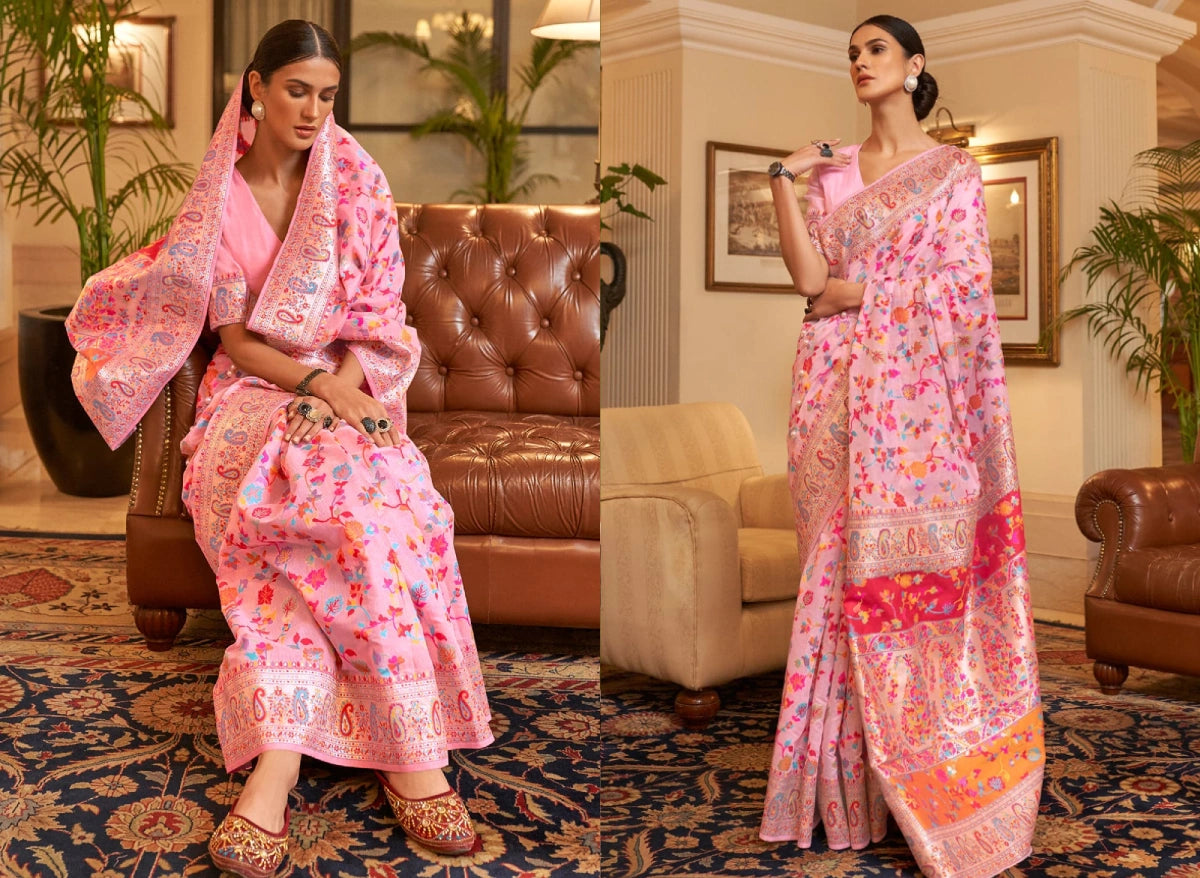
The Kani saree is perhaps the most regal of all — woven with pashmina wool and decorated with intricate motifs using wooden sticks called 'kanis'. It comes from the Kashmir valley, especially from Kanihama village. Unlike printed or embroidered shawls, every motif here is woven into the fabric, using a coded pattern known only to the weaver.
The designs often include chinar leaves, paisleys, almond motifs (badam), and vines. The base colours are usually muted — ivory, beige, charcoal — allowing the motif threads to shine through.
Kani sarees are rarely worn casually. They are winter heirlooms, draped for weddings in Srinagar, gifted to brides, or folded carefully in cedar trunks as family treasures.
26. Balaramapuram Saree – Kerala

Balaramapuram sarees are Kerala’s most historic weave. Made of unbleached cotton with pure gold zari, these sarees are used in rituals, weddings, and formal events across the state. Unlike Kasavu which uses artificial zari today, traditional Balaramapuram zari was drawn from actual gold coins and beaten into wire.
The weave is dense but soft. There are no motifs — only structure, purity, and legacy. These sarees are usually cream in colour with wide gold borders, and are worn with red, green, or black blouses.
Even temple priests wear veshtis made from the same loom — adding a sacred dimension to every fold.
27. Maheshwari Saree – Madhya Pradesh

Woven in Maheshwar town on the banks of the Narmada River, these sarees blend silk and cotton and are known for their sharp checks, stripes, and reversible borders. According to legend, they were designed by Queen Ahilyabai Holkar herself for royal women.
The borders are called 'bugdi' or 'rui phool', while the pallu often has five stripes. Colours range from pastels to deep jewel tones, often without zari, making them ideal for summer weddings and temple visits.
A Maheshwari saree is lightweight, crisp, and formal — like a freshly ironed letter from a different century.
28. Rajkot Patola Saree – Gujarat

While the double Ikat Patan Patola is rare and expensive, Rajkot Patola offers a more accessible version. These are single Ikat silk sarees dyed with vibrant colours and sharp geometrical motifs — elephants, flowers, peacocks — dyed before weaving.
Rajkot Patolas are more wearable for day-to-day functions like Diwali gatherings, office parties, or even college farewells. The silk is smoother than its Patan counterpart and the colours are more flamboyant — orange, teal, pink, purple.
Still, the precision in design remains. Even if it is a “younger cousin” of Patan, Rajkot Patola carries its own swagger.
29. Shantipuri Saree – West Bengal

Hailing from the small town of Santipur in Nadia district, Santipuri sarees are known for their fine cotton, even weave, and smooth finish. These sarees carry narrow borders with rhythmic stripe patterns and traditional motifs like lotus, wheel, and fish — all handwoven.
The specialty lies in the consistency of the weave, achieved using pit looms and polished threads. Santipuri sarees are typically worn during the Bengali summer, Saraswati Puja, or while attending community events and addas.
They are budget-friendly, elegant, and ideal for women who want breathable cotton without sacrificing heritage.
30. Narayanpet Saree – Telangana

Originating from the border town of Narayanpet, these sarees were once patronized by the Maratha rulers. They are known for their checked bodies, striped pallus, and temple-inspired borders, woven in both silk and cotton.
The silk versions are bright — often magenta, green, or orange — and used for pujas, weddings, or community gatherings. Cotton Narayanpets are simpler, used as daily wear or school teacher uniforms across Telangana.
31. Ashavali Saree – Gujarat

These sarees are a hidden jewel of Gujarat’s weaving tradition. Woven in Ahmedabad, Ashavali sarees are silk-based with rich brocade borders often inspired by Mughal floral designs, temple architecture, and royal court scenes.
Earlier worn by queens and aristocrats, they fell out of favour but are now being revived by heritage textile activists. The sarees are heavier, grand, and resemble Banarasi styles — but with a Gujarati flair.
Ashavali sarees are usually worn for Garba nights, Gujarati weddings, and festivals like Janmashtami and Navratri.
32. Thirubuvanam Silk Saree – Tamil Nadu

Woven in Thirubuvanam near Thanjavur, these sarees use pure silk with a high thread count — giving them a firm, rich texture. They're known for their longer pallus, intricate geometric or temple motifs, and subtle colour combinations.
Unlike Kanchipuram sarees, Thirubuvanam silks are more affordable and slightly lighter, making them popular among middle-class Tamil families for functions, engagements, and cultural events.
The weavers here work through co-operative societies, ensuring that traditional methods survive even in the face of powerloom threats.
33. Patan Patola – Gujarat
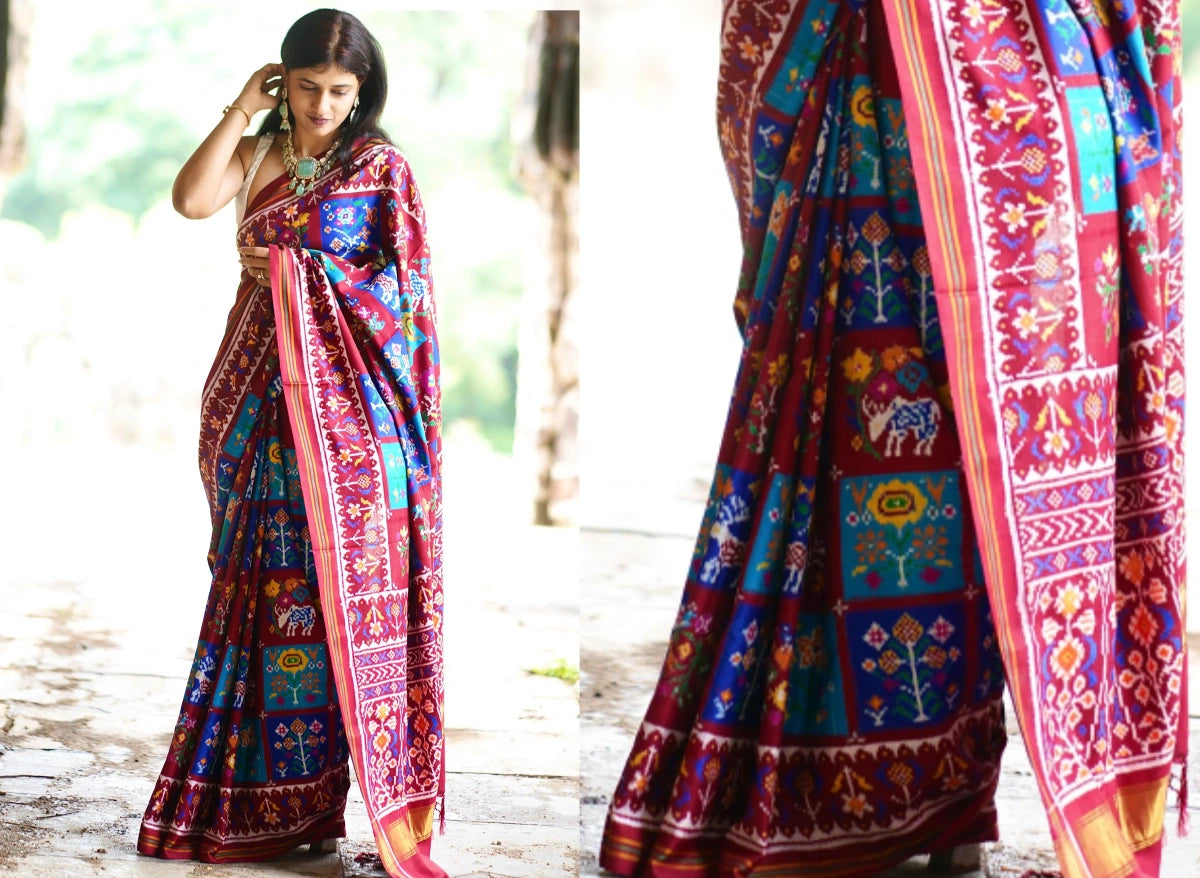
Double Ikat is rare — and Patan Patola is one of the finest. Woven in Patan by the Salvi family for centuries, these sarees are created by dyeing both warp and weft before weaving. The alignment must be precise — any mistake ruins the pattern.
Motifs are traditional: parrots, elephants, flowers, and dancing women. The silk is luxurious, and a single saree can take six months to finish. Worn by royalty and now by high-end collectors, these are not daily wear — they are museum-worthy.
If you ever find a real Patola, treasure it. It is geometry woven with breath.
34. Telia Rumal – Telangana

Telia means "oily". These sarees are woven using yarn soaked in castor oil and ash — making them smoother, stronger, and darker in tone. Originally used to create square scarves (rumals), the technique was adapted into full-length cotton sarees with bold red, black, and white geometric motifs.
Today, Telia Rumal sarees are worn at weddings, exhibitions, and as part of Telangana’s cultural identity. They drape cool and fall gracefully — with patterns that look sharp but feel soft.
35. Swetambari Saree – Varanasi, U.P.

One of the four sacred sarees of Banaras (alongside Raktambari, Pitambari, and Nilambari), Swetambari is known for its **ivory-white base with gold zari work**. Traditionally worn during temple visits, Ganga aarti, or spiritual ceremonies, it reflects simplicity and sanctity.
The silk is fine, and the zari borders include lotus, diya, or temple dome motifs. It's not common on commercial racks — usually woven on order for religious occasions or classical dancers.
Swetambari glows softly — like sunlight on river steps.
36. Berhampuri Patta – Odisha

Also called ‘Brahmapur Phoda Kumbha’, these sarees have a distinct temple border with double-line weaving and long pallus. The texture is rich, the fall is stiff, and the colours are mostly maroon, black, and ochre.
Worn by Odia women during Durga Puja, marriage rituals, and cultural performances, these sarees are easy to spot but hard to imitate. The weaving uses pit looms and traditional wooden tools — no electricity involved.
A Berhampur Patta tells you it is from Odisha the moment it enters a room.
37. Gollabhama Saree – Telangana

Gollabhama means ‘milkmaid’ — and these sarees are named after the embroidered figures of women carrying pots. Woven in Siddipet, they use cotton or silk-cotton blends and feature the iconic dancing girl motif along the border and pallu.
Earlier, these were worn during folk festivals and temple fairs. Today, designers reinterpret them for ramp shows and handloom showcases.
A Gollabhama is charming, cultural, and proudly rural.
38. Salem Silk Saree – Tamil Nadu

Woven in Salem using mulberry silk, these sarees are known for their bold borders, vivid colours, and tight texture. The pallu usually carries temple motifs or stylized checks and stripes.
Worn widely across Tamil Nadu for weddings, ear-piercing ceremonies, and Navratri golu visits, they are soft but structured. Salem silks are often underrated — but never out of place.
Whether you are buying your first saree or rediscovering what your grandmother wore — you are part of this story now.
Complete List of 116 Recognized Handloom Sarees
- Satin Tanchoi
- Banarasi Jungla
- Banarasi Shikargah
- Banarasi Butidar
- Banarasi Cutwork
- Banarasi Rangkat
- Awad Jamdani
- Nilambari
- Pitambari
- Raktambari
- Swetambari
- Mubarakpur Lachcha Buta
- Meerut Zari Silk
- Lalitpur Zari Silk
- Kani Pashmina
- Ikat Pashmina
- Kota Doria
- Anwa
- Pattu
- Paithani
- Kunbi
- Karvath Kati
- Nagpur Cotton
- Raghvi
- Lugda
- Jyot
- Maheshwari
- Chanderi
- Baiga Chakdhariya
- Patan Patola
- Rajkot Patola
- Tangaliya
- Ashavali
- Kuchchi/Bhujodi
- Champaa Tussar
- Gheecha Silk
- Bastar Mae Lugda
- Bomkai
- Habaspuri
- Kotpad
- Siminoi
- Mayurbhanj
- Bichitrapuri
- Sachipar
- Khandua
- Gopalpur Tassar
- Berhampur Patta
- Biman
- Dongoria
- Nabakothi
- Utakallaxmi
- Muga Silk
- Mekhela Chador
- Bhagalpuri
- Tassar
- Bawan Buti
- Jamdani
- Baluchari
- Santipuri
- Dhaniakhali
- Tangail
- Begumpuri
- Garad Korial
- Kantha
- Tussar (Jharkhand)
- Gichha
- Moirang Phee
- Pochampally Ikat
- Telia Rumal
- Narayanpet
- Gadwal
- Siddipet Gollabamma
- Armoor Silk
- Himroo Silk
- Pitambari Silk
- Kothakota Silk
- Mahadevpur Tassar
- Linen Ikat
- Muthyampeta Cotton
- Ramappa
- Uppada Jamdani
- Venkatagiri
- Chirala
- Kuppadam
- Dharmavaram
- Madhavaram
- Mangalagiri
- Polavaram
- Bobbili
- Payakaraopet
- Bandarulanka
- Paturu
- Kanchipuram
- Kanchi Cotton
- Arni
- Ponnur
- Woraiyur
- Madurai
- Chettinadu Kandangi
- Paramakudi
- Aruppukottai
- Dindigul
- Thirubuvanam
- Vilandai
- Chedi Butta
- Koorainadu
- Kovai Kora
- Coimbatore
- Salem
- Negamam
- Molakalmuru
- Ilkal
- Gandaberunda
- Anekal
- Balaramapuram
- Kuthampully
- Kasargode
 New Arrivals
New Arrivals
 Saree Weaves
Saree Weaves
 Banarasi Sarees
Banarasi Sarees
 Kanjivaram Sarees
Kanjivaram Sarees
 Paithani Sarees
Paithani Sarees
 Patola Sarees
Patola Sarees
 Organza Sarees
Organza Sarees
 Chikankari Sarees
Chikankari Sarees
 Kashmiri Jamawar Sarees
Kashmiri Jamawar Sarees
 Dola Silk Sarees
Dola Silk Sarees
 Dharmavaram Silk Sarees
Dharmavaram Silk Sarees
 Saree Fabric
Saree Fabric
 Silk Sarees
Silk Sarees
 Soft Silk Sarees
Soft Silk Sarees
 Linen Sarees
Linen Sarees
 Satin Sarees
Satin Sarees
 Digital Printed Sarees
Digital Printed Sarees
 Tissue Silk Sarees
Tissue Silk Sarees
 Occasion
Occasion
 Festive Wear Sarees
Festive Wear Sarees
 Office Wear Sarees
Office Wear Sarees
 Party Wear Sarees
Party Wear Sarees
 Luxe Collection
Luxe Collection
 Wedding Collection
Wedding Collection
 Engagement Sarees
Engagement Sarees
 Haldi Sarees
Haldi Sarees
 Sangeet Sarees
Sangeet Sarees
 Wedding Banarasi Sarees
Wedding Banarasi Sarees
 Wedding Kanjivaram Sarees
Wedding Kanjivaram Sarees
 Wedding Organza Sarees
Wedding Organza Sarees
 Wedding Patola Sarees
Wedding Patola Sarees
 Sarees By Color
Sarees By Color
 Price Range
Price Range
 Designer Silk Sarees
Designer Silk Sarees
 Track Your Order
Track Your Order
